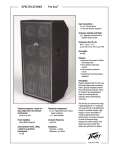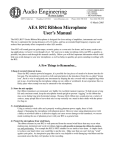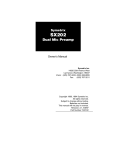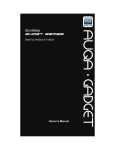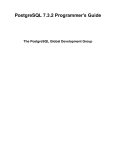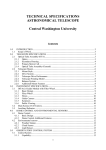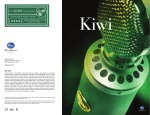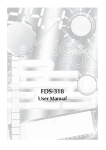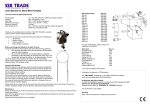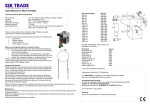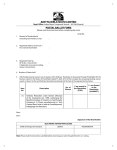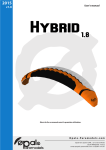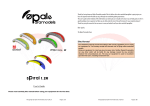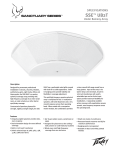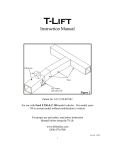Download N22 Owner`s Manual
Transcript
ribbonmics & preamps since 1964
www.ribbonmics.com | tel: +1-626-798-9128 | fax: +1-626-798-2378
ma
de in
c a l i fo r
nia
aea n22
PHANTOM-POWERED RIBBON MICROPHONE
{ OWNER’S MANUAL }
Revision 3, July 2015
{ WELCOME}
Congratulations on your purchase of the AEA N22 phantom-powered
ribbon microphone and welcome to the AEA family. The AEA N22 was
designed with the singer-songwriter musician in mind. Hard working
artists, honing their musical craft for many years, feel strongly about
their personal tone, so they need a microphone that translates their
signature sound in a recording. Whether you are a musician, home
studio owner, or experienced producer/engineer, you will find that the
N22 provides a great ribbon tone without the need for EQ in most
applications. Most importantly, the N22 was designed by listening first,
and measuring only after experienced musicians told us the microphone
sounded great. Bridging the gap between vintage and modern, ribbon
and condenser, studio and live, the N22 is the perfect companion for
musicians and engineers alike.
Your N22 microphone is 100% handcrafted in Pasadena, CA. AEA is a
family owned company with a small crew of skilled technicians – most
of them being musicians themselves. Proudly independent, we still
manufacture all our ribbon microphones and preamps by hand from
locally sourced parts.
We hope that the N22 will help you capture many magical performances
that touch the heart. Read this manual thoroughly to make sure that you
get the best sound and longevity from your new microphone. Please
don’t be a stranger and become part of the AEA community by sharing
your experiences with the N22 via e-mail, phone or our social media
channels.
Wes Dooley
President of AEA
2
{ TABLE OF CONTENTS}
WELCOME2
INTRODUCTION4
GENERAL GUIDELINES4
APPLICATION ADVICE5
Controlling Leakage
5
Proximity Effect6
APPLICATION EXAMPLES7
Vocals7
Acoustic Guitar8
Electric Guitar & Bass
8
Drums9
PRECAUTIONS9
Phantom-power9
Wind Gusts9
Tramp Iron10
Microphone Positioning
10
Magnetic Stray Fields
11
SPECIFICATIONS12
WARRANTY14
SUPPORT14
{ INTRODUCTION}
The N22 is a side-address, phantom-powered ribbon microphone with a
bidirectional (or figure-of-8) pickup pattern. It was designed for closeup miking applications like acoustic and electric guitars, vocals, drums,
or piano, but it is also well suited to be used at a distance thanks to
its healthy output level. With phantom-powered JFET electronics and
a custom German transformer the N22 achieves optimal performance
with a wide range of preamps ranging from vintage high-end models
to USB or Firewire audio interfaces in home studio setups. The highly
protected pure aluminum ribbon allows for using the N22 in live sound
applications and vocal recording without the need for an additional
pop-filter. The N22 is the first member of AEA’s NUVO series. Rooted
in the RCA tradition just like other AEA ribbons, all NUVO microphones
are designed to offer a fresh approach to the ribbon transducer and
represent Wes Dooley’s take on the evolution of the ribbon microphone.
{GENERAL GUIDELINES}
The two sides of the N22 (front and back) are voiced exactly the same,
but keep in mind that the backside has opposite polarity compared to
the front. Positive polarity is achieved by positioning the side with the
“NUVO” logo towards the sound source.
The supplied microphone clip will provide adequate vibration isolation in
most situations.
To maintain the best performance from your new AEA N22 microphone,
take note of these four basic rules:
1)
2)
3)
4)
Keep the microphone covered when it is not in use.
Always use a sturdy microphone stand.
Never expose the microphone to strong air turbulence.
Be nice to the microphone, and it will be nice to you.
1) Keeping the microphone covered when it is not in use will reduce the
possibility of damage that might result from a sudden gust of air coming
from air-conditioning or an open door or window. Place the supplied
protective bag (or a standard plastic bag) over the microphone when
it is not in use. For longer-term storage, replace the microphone in its
protective case.
4
2) While the N22 was designed to work well with all standard
microphone stands, a high-quality boom stand will still make your
life a little bit easier. Mounting the microphone on a strong, sturdy
microphone stand with a heavy base (or tripod)
is essential. If you are using a boom, make sure that it is properly
balanced and make sure the tripod legs are positioned appropriately to
prevent tipping.
3) Ribbon microphones can withstand very high SPL (sound pressure
levels) without difficulty, but can be damaged easily by a sudden, strong
gust of air or high levels of low frequency sound waves (like from a
kick drum or bass cabinet). This can stretch the ribbon, causing the
microphone to lose sensitivity and distort its frequency response. To
avoid possible damage, follow this simple procedure when positioning
the microphone. Put the back of your hand where the mic will be; if you
can feel the motion of air on your hand, place a pop-filter between the
microphone and the source of the air turbulence. When recording kick
drums or bass guitar cabinets, angle the microphone to make sure that
no wind blasts hit the ribbon head-on.
4) Your N22 is a valuable and important investment. Like any piece of
recording equipment or musical instrument, it requires common sense
and good basic care to keep it working properly. Given simple, basic
care as described above, your new microphone will perform admirably
for decades.
{APPLICATION ADVICE}
Controlling Leakage
A significant and ever-present challenge in contemporary studio
recording is minimizing “bleed” (also called “leakage” or “crosstalk”)
from nearby instruments into the various microphones. The deep nulls
of bidirectional ribbon microphones provide good rejection of unwanted
sounds, which also can be beneficial in sound reinforcement situations
where feedback is always a threat. While gobos can be effective in
isolating performers from each other, they introduce their own set of
problems - not the least of which are reflections in close proximity to
the performers and/or microphones that result in comb-filter distortions.
Because gobos usually are bulky, they also inhibit the ability of the
musicians to hear and see each other easily. Such a setup requires
complex and often cumbersome headphone monitor mixes for the
musicians.
5
Because the N22 has a bidirectional pattern, it has nulls at 90° / 270°
from the principal (front) axis. Projected in three dimensions, these nulls
produce a “plane of rejection” to the sides of the microphone that can
be used effectively to reduce leakage. Simply arrange the musicians
so that nearby instruments are placed in the “null” of their neighbor’s
microphone, and vice versa. Although this does not entirely eliminate the
need for gobos, it can significantly reduce their number.
Keep in mind that a certain degree of bleed doesn’t necessarily have
to be bad. For some styles and genres it can in fact be beneficial to
embrace a little bit of bleed in order to create cohesive and natural
sounding recordings. The important thing to listen for is whether or
not other instruments that bleed into a specific instrument microphone
still sound natural. You will generally find that well-designed ribbon
microphones like the N22 capture a natural off-axis sound, which means
that bleed from other instruments can contribute to the overall sound in
a pleasing way.
Proximity Effect
Proximity effect is a characteristic of all directional microphones; it
is a rise in low-frequency response that increases at closer working
distances. While this can be used to good effect, particularly with male
voices to give them an enhanced richness and depth, the potential trade
off is reduced articulation or clarity that can result from the masking
effect on the treble due to “excessive” bass boost.
6
Experienced vocalists instinctively locate the proper working distances
for the microphones they are using. From as early as the 1930s,
Frank Sinatra always kept one hand on the microphone stand while
singing. Some joked that he simply was steadying himself, but more
knowledgeable people noticed that he would bring the mic closer for
more intimate moments, and then move it farther away when he belted
out a line. This technique became known as “working the mic.” A
simple technique for maintaining the proper working distance from the
microphone is to place a pop-screen between the performer and the
microphone. By doing this, nothing need be said to the performers, as
they naturally will work at the distance you have established.
Your N22 was designed to exhibit significantly less proximity bass boost
than other figure-of-8 ribbon microphones, so that it has a balanced
sound at relatively small distances to the sound source. You will find
that the N22 works particularly well at similar distances as you would
choose for condenser microphones rather than at distances that would
be appropriate for traditional ribbon microphones.
Application Examples
Your ears are obviously the best judge of microphone choice and
placement, but AEA has garnered a great deal of experience testing
the N22 in a variety of recording settings and by talking to experienced
musicians and engineers. As a result we suggest the following
guidelines to help you achieve optimal results when using the N22.
Watch the videos on our website (www.ribbonmics.com, www.
aeasessions.com) and on our YouTube channel
(www.youtube.com/AEAribbonmics) for more tips and tricks for our
microphones and preamps.
Vocals
Thanks to the improved pop-protection of the N22 you can use
the microphone at close distances just like you would choose for a
condenser microphone. If you should encounter problems with plosives,
it is advised to use a pop-filter.
The microphone has a vertical sweet spot that sits in the middle
between the top and bottom edges of the black cloth covered grill
basket. When positioning the microphone, choose an appropriate
stand or boom setup to accommodate for the height of the vocal talent
in order to achieve the best sound. Every singer will move a bit while
performing, but since the sweet spot is located in both the horizontal
7
and vertical axes, it is fairly wide and forgiving.
If you are recording a musician who sings and plays an instrument at the
same time, you can make use of the exceptional rejection offered by the
90º “null” planes of the bidirectional pickup pattern to reduce the pickup
of the instrument in the vocal microphone.
Acoustic Guitar
When recording a solo guitar a good starting point is to position the
N22 four to six inches (10-15 cm) away from the guitar roughly pointing
at the 12th fret or where the neck meets the body. The closer you move
towards the sound hole, the more bass you will get.
Again, if you are recording a singer-songwriter who sings and play
another instruments at the same time, you can make use of the
exceptional rejection offered by the 90 degree “null” planes of the
bidirectional pickup pattern to reject the vocal in the guitar microphone.
Electric Guitar & Bass
The N22 can handle very high sound pressure levels and has improved
wind protection, so it can absolutely handle loud electric and bass
guitars right on the grill of the amp. Identify where the center of the
speaker cone is located and place the N22 a few inches (5-10 cm)
away from the speaker pointing right at its center for a very direct,
“in-your-face” sound. This is the spot that will obtain the most highfrequency content. If it sounds too harsh, try moving the microphone
slightly off center of the speaker cone. You can also try positioning the
N22 at an angle. You will find that small differences in positioning can
make huge differences in the sound, so experiment until you find the
spot you like.
When using multiple microphones on a cabinet at once and mixing
them to create a particular sound, it is important to pay attention to
the phase relationship between the different signals. Try to position
the different microphones as close to each other as possible, to avoid
phase problems caused by sound arriving at the microphones at slightly
different path lengths. Make sure to listen to the combined signal
summed to mono to catch potential comb filtering that could be caused
by out-of-phase signals. If you are recording with the back lobe of the
N22, it is important to invert the polarity on the preamp or DAW.
For a more natural sound that captures the sound of the amp in your
8
room, try backing the microphone up a couple of feet.
Drums
Although the N22 may work well for traditional ribbon mic placement
techniques like overheads or room mics, it is particularly well-suited
for more close-up applications like drum underheads, kick or snare.
On snare drum, the N22 really brings some character to the table that
will be hard to find in an SM57. Use the null plane of the figure-of-8 to
reject the hihat. If you have a drummer that plays very well balanced (yes,
this might be rare), position the N22 so that its back side picks up the
hihat as well.
{PRECAUTIONS}
Most ribbon microphones need little, if any, maintenance. Given proper
care they last for decades. Bing Crosby’s personal RCA-44BX (now in
the collection of the Pacific Pioneer Broadcasters in Hollywood) sounds
as good today as it did when he recorded his radio broadcasts in the
1940s.
A few simple precautions will help you to keep your AEA N22 working
well for life.
Phantom Power
Although the N22 needs a standard 48V phantom-power source to
operate, you should still make sure that phantom-powered is turned off
before plugging and unplugging the microphones. The loud pops that
occur when the microphone is plugged in with phantom-power engaged
can damage speakers, headphones, and ears. Since passive ribbon
microphones or other transformer-coupled microphones are particularly
sensitive to phantom-power, it is recommended to make disengaging
phantom-power before plugging and unplugging a habit.
Wind Gusts
A second and equally important rule is never to blow directly into a
ribbon microphone to test it. Strong air turbulence can stretch the
ribbon diaphragm and while it may not break, it will nonetheless
significantly degrade the microphone’s performance. The ribbon in the
N22 is highly protected by multi-layered screens and cloths to provide
9
superior wind protection compared to many other ribbon microphones
so that the microphone can be used for recording vocals without the
need for a pop-filter. Nonetheless, using it outdoors requires special
care to avoid wind which can damage the ribbon. Indoors, however,
it is also important to avoid serious air movement from stage curtains,
open windows, doors, or air-conditioning systems. Use the supplied
cloth bag to cover the microphone whenever it is not in use. High SPL
sound sources do not usually pose a problem because most ribbon
microphones can handle 130 dB SPL or more without difficulty. It
is only those “explosive” sources that produce a strong blast of air,
such as the bass port on an electric guitar or bass amp, a guitar being
plugged (or unplugged) while the amp level is turned fully up, an onaxis kick-drum (particularly with a port on the front head), that are
potentially damaging. If you are unsure about how much wind is hitting
the microphone, place the back of your hand where the microphone is
going to be. If you can feel significant wind blasts, angle the microphone
or use a pop screen to avoid direct hits.
Tramp Iron
Minute iron particles, sometimes known as “tramp iron,” are common
within our environment. AEA ribbon microphones contain powerful
magnets that produce strong magnetic fields. These fields can attract
any ferric metal near the microphone that, if they are small enough, can
penetrate the outer screening and work their way inside the microphone.
Over time, this “tramp iron” can build up sufficiently in the magnetic gap
to rub against the ribbon causing distortion, electrical shorts or tearing
of the ribbon. The best prevention is to keep the microphone covered
with the supplied plastic bag when it is not in use.
Under no circumstances should you disassemble and take the grill off of
the microphone as this could allow tramp iron to enter the narrow gap
between the ribbon and the pole pieces. Disassembling the microphone
will VOID your warranty.
Microphone Positioning
The shock-mounted clip that is supplied with the N22 microphone
was designed to keep structure-borne noise transmitted through the
microphone stand away from the low-tuned ribbon transducer. For the
shock mount to function as intended and to avoid vibration entering
the microphone through its attached cable, it is important to tie the
microphone cable to the microphone stand in a loop with a cable tie,
shoelace or string.
10
Magnetic Stray Fields
Ribbon microphones are fundamentally prone to picking up strong
external magnetic fields caused by light dimmers or nearby power
transformers. Guitar players will know this phenomenon from single-coil
pickups. Even though much attention was paid to suppressing such
sensitivity to external magnetic fields in the design of the N22, it is still
possible that you might encounter this problem. If you should pick up
a hum, try rotating or moving the microphone to find a spot where the
hum disappears, and try eliminating potential sources of stray magnetic
fields. You can use the microphone to find where hum is originating.
Rotate the mic for maximum interference and move it back and forth to
sense its direction.
The high-performance magnets used in the KU4 and R44 are incredibly
strong, and a significant amount of stray magnetic field lines surround
the microphone. Avoid placing the microphone in close proximity
to hard drives, credit cards, analog tape, or any other magnetically
sensitive items to prevent any data loss. These classic ribbon mics were
designed for maximum performance in professional environments with
well-trained technicians.
11
{SPECIFICATIONS}
Operating Principle:
Directional Pattern:
Frequency Range:
Maximum SPL:
Sensitivity:
Output Impedance:
Recommended Load Impedance:
Phantom power:
Polarity:
Pressure gradient transducer
Bidirectional
<20 Hz to >20 kHz
141 dB SPL (1% third harmonic > 1 kHz)
6.2 mV/Pa (at 1 kHz, no load)
92 Ω broadband
Polar Response:
Horizontal:
Native bidirectional, figure-of-8 pattern
Up to 90 dB rejection at right angles to the
front/back axis.
Level changes with angle of incidence, but
frequency response is consistent.
Vertical:
1.0 kΩ or greater
P48 phantom power, 7 mA
Pin 2 high for positive pressure at the
front of the microphone.
Transducer Element
Material:
Thickness:
Width:
Length:
Pure aluminum corrugated ribbon
1.8 µm
0.185 in (4.7 mm)
2.35 in (59.7 mm)
Microphone Dimensions:
Height:
Width:
Depth:
Weight:
Shipping weight:
Connector:
8.83 in (32.4 cm)
1.62 in (11.7 cm)
1.62 in (9.5 cm)
12 oz (335 g)
1 lb 13 oz (810 g)
XLR-3M
12
Accessories Included:
Storage/shipping case, microphone stand clip,
custom protective mic sleeve, usermanual
13
{WARRANTY}
Your N22 microphone comes with a one-year limited warranty on parts
and labor, shipping not included. Please see the supplied warranty card
for details.
Registering your microphone with AEA will extend the warranty to a full
three years. Simply fill out the supplied registration form and send it to:
Audio Engineering Associates
1029 N. Allen Ave
Pasadena, CA 91104
You may also register your AEA equipment online at
http://www.ribbonmics.com/aea/form.php
{SUPPORT}
If you should encounter any problems with your microphone or if you
have questions regarding using the N22 in specific application, please
contact our customer support team at [email protected]
To talk to a live human being, call +1 (626) 798-9128, between 8:00
a.m.- 6:00 p.m. PT Monday through Friday.
There are a number or audio and video recordings of various AEA
microphones online. Please visit www.ribbonmics.com
Manufactured by AEA Ribbon Mics & Preamps
1029 N. Allen Ave. Pasadena, California 91104, USA
Tel: +626-798-9128 Fax: +626-798-2378 www.ribbonmics.com

















